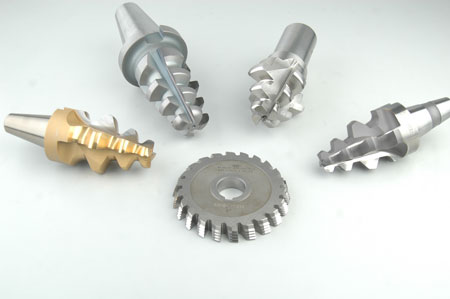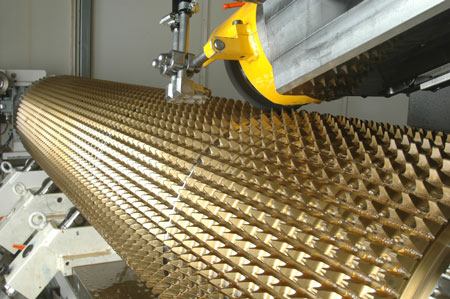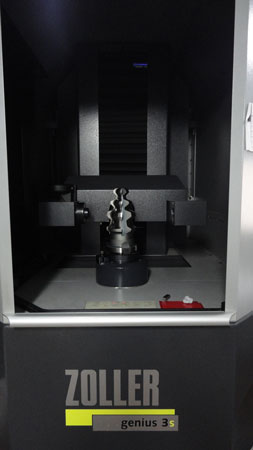Broach tools may look alike at first glance, but they don’t always perform the same. Some work the first run but don’t perform well after sharpening. Measuring performance over time is the proof in the pudding. Start by looking closely at your broaching tools, who made them, and how. This article by the “Broachman” will advise you on how broach tools should be made and sharpened to get consistent, reliable results to help you and your company save time and money by understanding how tool manufacturing methods affect optimized, stable process outcomes.
 If a factory is having problems with its broaching process, go directly to the source — the tool crib — to talk to the person responsible for sending the broach tools out for sharpening. The people working in the tool crib generally know how often there are issues, what tools work best, which ones have issues, and why. They interact daily with machine operators, setup people, engineering, and vendors. If there are recurring problems and patterns of tool performance and inconsistency, they will know.
If a factory is having problems with its broaching process, go directly to the source — the tool crib — to talk to the person responsible for sending the broach tools out for sharpening. The people working in the tool crib generally know how often there are issues, what tools work best, which ones have issues, and why. They interact daily with machine operators, setup people, engineering, and vendors. If there are recurring problems and patterns of tool performance and inconsistency, they will know.
With broach tools, here are the factors to consider in the manufacturing process that affect optimized, stable performance and outcomes:
- Tool design
- Material selection
- Coatings
- CNC manufacture
- Straightening
- Edge preparation
- Inspection
- Broaching
- Re-sharpening
This article will touch on each factor briefly. If you’re thinking: Why should I have to know how the tools are made, I just want to buy tools that work as expected and promised, every time, the answer to that is: If you don’t ask how they were made and how they will be sharpened, you won’t know. After all, they all look pretty much alike.
 Every person or company selling a broach tool wants you to believe they make the best tool and offer the best price or value. You need to ask questions about the tools. Price, while important, is not as important as optimized, consistent performance. For your process to be reliable and predictable, the tools need to provide optimized, stable performance; if your tools don’t, you will need to find out why. Chances are, it’s the manufacturing process.
Every person or company selling a broach tool wants you to believe they make the best tool and offer the best price or value. You need to ask questions about the tools. Price, while important, is not as important as optimized, consistent performance. For your process to be reliable and predictable, the tools need to provide optimized, stable performance; if your tools don’t, you will need to find out why. Chances are, it’s the manufacturing process.
To understand the different approaches manufacturers use to make broach tools that may affect optimized, stable performance of the tools, consider this: In the American broach tool industry today, a lot of the companies are still making broach tools on machines made more than 50 years ago. These machines have been rebuilt and handed down over time, and they are used to make broaches daily — in the same way they were made by my grandfather 60 years ago and the same way as when I started making broach tools in 1979.
With the older machines in use and without 100 percent of the tools made on CNC machines, this is introducing unmeasurable variation into the process. Quality and delivery is impossible to control. However, process instability is not normal. The companies that have invested in the newest technology domestically or internationally can now make broach tools with consistently optimized, stable performance, and many times, at a lower cost. The most complicated broach tools that consistently perform are now only made by the companies that have fully embraced technology and invested in CNC machine tools for every manufacturing operation, personnel training, and process control procedures.
Process Factors
The following covers the process to make and sharpen a tool.
 Tool design is based on the engineer’s approach, considering part specifications and tolerances, including material and hardness. Most generally, a cookbook recipe is used, so to speak. A clever engineer or person with historic experience can also consider designs that can improve a tool’s performance. A great way to continually improve a tool’s design-based performance is to inspect the tools before each re-sharpening and document where the tool is wearing most, over time, and redesign the cutting approach to “even out” the wear and maximize tool life.
Tool design is based on the engineer’s approach, considering part specifications and tolerances, including material and hardness. Most generally, a cookbook recipe is used, so to speak. A clever engineer or person with historic experience can also consider designs that can improve a tool’s performance. A great way to continually improve a tool’s design-based performance is to inspect the tools before each re-sharpening and document where the tool is wearing most, over time, and redesign the cutting approach to “even out” the wear and maximize tool life.
Material selection is generally some grade of high-speed steel or possibly carbide. The grades of steel that broach tools are made of have evolved. Many toolmakers, who have always used M2, now select powdered steel, low carbon/high vanadium, bridge alloys, and/or proprietary blends from a variety of producers. From an applications standpoint, each can have an advantage based on the part being cut and customer process requirements. The tool’s material is generally specified by the tool design engineer and approved by the customer. Beyond the standard grades, you may need to reach out to those with more application resources (I recommend Griggs Steel).
Coatings or surface treatments are also recommended by the tool designer, approved by the customer, and almost always the right choice. It’s important to evaluate the reason for the coating: to lower the coefficient of drag, get a harder cutting surface to produce more parts per cycle, or to meet part surface finish requirements. It’s also important to calculate cost versus return, with each coating considered or tested. More parts do not mean a lower cost-per-part. Some coatings are prohibitively expensive based on the additional number of parts they help a tool to produce. For some applications, a nitriding surface treatment is the lowest cost and best value, and in other applications, TiN or some other PVD coating or multi-layer coating like Alcrona Pro is better. Every application is slightly different; testing coatings on a long running part is always a good idea.
 CNC manufacture: Always insist on 100-percent CNC-made tools. Introducing manual operations into making broach tools introduces variability that will inevitably show up in the broaching process. This means CNC turning, milling, drilling, and every finish grinding operation, especially CNC profile dressing, CNC spline grind, and CNC sharpening, should be done on modern equipment.
CNC manufacture: Always insist on 100-percent CNC-made tools. Introducing manual operations into making broach tools introduces variability that will inevitably show up in the broaching process. This means CNC turning, milling, drilling, and every finish grinding operation, especially CNC profile dressing, CNC spline grind, and CNC sharpening, should be done on modern equipment.
Straightening a tool during the manufacturing process and before shipping is critical to tool performance; the tool must be straight to perform at its best consistently. Excess peening should be avoided, with a focus on heat straightening in-process. Ask your supplier what tolerance for tool straightness to expect.
Edge preparation can be done several ways. In the end, what’s most important is that there is no burr on the tool from grinding, and it’s sharp. A tool with a grinding edge burr before the first part is broached will broach 30-percent fewer parts before it requires sharpening. You can test this with a fingernail or straight pin, feeling the edge burr. If you feel one, it should be removed before broaching.
Inspection reports are a part of good process control. Most every vendor will have, at a minimum, an internal report. Ask for a copy of the tools inspection report, and look over them occasionally.
Broaching, of course, is a whole other topic. There is a lot that can go wrong in broaching, including setup, part material changes, coolant, and tool handling, just to mention a few. A reliable, consistently well-made broach tool is the first step to a stable process. The next step is not over-running the tools. While it’s tempting to get 300 more parts, the last 300 can cause more tool wear than the first 3,000. The rule of thumb is, when a tool has 0.005″ of visible land wear, take it out for sharpening. If you have questions on how or where you should be measuring land wear, contact a broaching expert.
 Sharpening is a predominant key to process stability. Broach tool sharpening is, by far, the biggest process problem in broaching. This part of the process is often underestimated. Process analysis most often comes back to sharpening as the root cause for process instability issues. Regardless of whether your sharpening is done in-house or your company is using a vendor to sharpen your broach tools, the process will only be optimized if the tools are sharpened on a CNC tool grinder by an operator with a trained eye. There are many CNC sharpening benefits that will affect the cost per part in broaching.
Sharpening is a predominant key to process stability. Broach tool sharpening is, by far, the biggest process problem in broaching. This part of the process is often underestimated. Process analysis most often comes back to sharpening as the root cause for process instability issues. Regardless of whether your sharpening is done in-house or your company is using a vendor to sharpen your broach tools, the process will only be optimized if the tools are sharpened on a CNC tool grinder by an operator with a trained eye. There are many CNC sharpening benefits that will affect the cost per part in broaching.
Also, a comprehensive sharpening and inspection process procedure should be in place, and the sharpening and inspection process should be documented for optimization review. If this is overlooked, then it’s “off to the Milky Way” as W. Edwards Deming, the father of modern management thinking, was fond of saying.
Conclusion
If your broach process seems unstable, first, investigate how the tools are made and sharpened. Insist on tools that are CNC made and sharpened, as it’s the only way to assure consistency. The design, material, and coatings can be tested and improved over time, but without CNC manufacturing and sharpening, the process will never be optimized and stable. CNC-made and sharpened broach tools are as necessary as breathing.
It’s also strongly suggested to use metrics to visually display the value of continual process improvements and the resulting cost savings — monthly and annually.






































